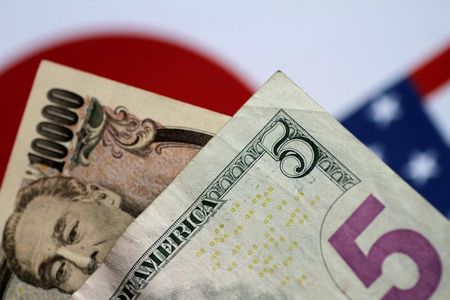Asia FX weakens as rate jitters boost dollar; yen steadies on intervention talk
2025.01.08 00:15

Investing.com– Most Asian currencies drifted lower on Wednesday as growing bets on a slower pace of U.S. interest rate cuts supported the dollar, while the Japanese yen steadied as government officials warned of potential intervention.
Regional markets were also grappling with worsening trade relations between the U.S. and China, after Washington added two major Chinese companies to a blacklist of firms with ties to the Chinese military.
The move comes just before President-elect Donald Trump’s inauguration on January 20, with Trump having vowed to impose steep trade tariffs on China. The Chinese yuan’s pair steadied after touching its weakest level in 17 years earlier this week.
Among other Asian units, the South Korean won’s pair rose 0.1% amid persistent political uncertainty in the country.
The Singapore dollar’s pair rose 0.1%, while Indian rupee’s steadied at 85.8 rupees after hitting record highs above 86 rupees last week.
Dollar upbeat on strong labor, PMI data
The and steadied in Asian trade on Wednesday, after rising sharply in overnight trade.
The greenback was boosted chiefly by stronger-than-expected data for November, which showed the labor market remained robust. The data came just days before key data for December, which is set to offer more definitive cues on the labor market this week.
Strong data also spurred bets that inflation will remain sticky in the coming months, giving the Federal Reserve more impetus to cut rates at a staggered pace.
The central bank warned that it will substantially slow its pace of rate cuts in 2025 on concerns over sticky inflation and strength in the labor market.
Higher for longer U.S. interest rates bode poorly for Asian markets, given that they herald a smaller rate differential for regional assets.
Japanese yen steadies amid intervention talk
The Japanese yen’s pair hovered around the low 158s on Wednesday, after recovering marginally from its weakest level in nearly six months.
The yen stemmed its recent losses after government officials offered a verbal warning on potential currency market intervention, which saw traders adopt more caution in shorting the Japanese currency.
The prospect of higher U.S. interest rates and a dovish outlook from the Bank of Japan battered the yen through December, putting the USDJPY pair close to levels that had last invited intervention by the government.
Traders are viewing 160 yen as a potential point of intervention.
Australian dollar flat as markets weigh mixed CPI data
The Australian dollar’s pair recouped early losses to trade flat as traders digested mixed inflation data from the country.
Headline inflation read higher than expected for November, while underlying inflation eased slightly.
The reading offered differing cues on when the Reserve Bank of Australia could begin cutting interest rates, given that core inflation still remained above its 2% to 3% target range.
Analysts expect the RBA to begin cutting rates only by the second quarter, although Wednesday’s data did spur some bets on an earlier cut.








